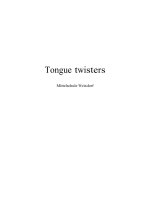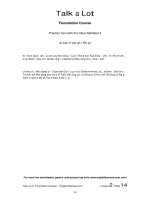learn the sounds of english with the clear alphabet
Bạn đang xem bản rút gọn của tài liệu. Xem và tải ngay bản đầy đủ của tài liệu tại đây (504.67 KB, 3 trang )
Talk a Lot
Clear Alphabet Dictionary
Learn the Sounds of English with the Clear Alphabet – Sample Lesson Plan
Activity Type:
Introduction to the sounds of English with the Clear Alphabet
Level:
Elementary – Pre-Intermediate
Skills:
Speaking & Listening; Pronunciation
Class Size:
Whole group lesson, e.g. ten students in a group
Time:
1 hour
Aim:
To introduce the sounds of English with the Clear Alphabet; to lay the
foundations for further study with the Clear Alphabet
Materials:
x1 Clear Alphabet chart handout (p.17) per student, whiteboard and
pens; students have their notebooks and pens
Note: this lesson focuses on teaching the vowel sounds of English, with only a little focus on
the consonant sounds. This is because most of the consonant sounds can be guessed at,
because they are encountered in English already (e.g. g , t , d , etc.). The vowel sounds
are more difficult to learn from scratch, so we spend more time with them during this lesson,
although we do also look at some of the stranger-looking consonant sounds (e.g. ng , tt ,
zz , etc.) towards the end of the lesson.
Procedure:
1. Give out the handouts as students come into the class. This gives them time to look at
them, comment (e.g. “On no!”), and get ready for the lesson.
2. Tell students that you’re going to learn the sounds of English with the Clear Alphabet. Write
on the board:
Vowel sounds
Your language: ___
English: ___
Elicit how many vowel sounds there are in your students’ first language (or different students’
first languages for mixed nationality groups), and write it on the board. Make sure you know
that answer before the lesson, e.g. in Polish there are 8 vowel sounds. Elicit from students
how many vowel sounds there are in English (23). No doubt they will be surprised at the
disparity between the two numbers. In English there are a lot of vowel sounds! Explain that
lack of knowledge of English vowel sounds causes many mistakes in pronunciation.
3. Explain why you are doing this activity today. When I did this, I read a short text in Polish
(which my friend helped me to write, because I’m an elementary rather than fluent Polish
speaker). The text helped the students to understand the aims of the lesson. It went
something like this (in Polish):
For more fun worksheets, games, and quizzes log onto englishbanana.com now!
Talk a Lot Clear Alphabet Dictionary
English Banana.com
41
Talk a Lot
Clear Alphabet Dictionary
Learn the Sounds of English with the Clear Alphabet – Sample Lesson Plan
“If you know the phonetic alphabet, you know how to pronounce words. This alphabet gives
you power. Power!”
(Here I emphasised the word “power” (“moc”) in Polish for comic effect, as well as to make my
point: “Da wam moc! Moc!” – “Gives you power! Power!”)
“You will be able to speak better in English. Polish is a phonetic language. In general, you
write like you speak.”
(Here I stopped to emphasise this important concept. I pointed out that, for example “The
letter ‘a’ in Polish is always pronounced a , and the letter “o” in Polish is always pronounced
o . Pronunciation in Polish is generally easier than in English.” The students agreed. I asked
them in Polish: “Is English a phonetic language?” The students grimaced and shook their
heads, laughing, because no, of course English is most definitely not a phonetic language!)
“English is not a phonetic language. We write differently to how we speak.”
(I illustrated this by writing the following words on the board: “my”, “high”, “pie” and eliciting
the pronunciations. I wrote each word phonetically and explained that in the dictionary there
are two spellings for each word. The normal spelling is usually no help at all for working out
the sound of the word. By contrast, the phonetic spelling gives us the sound of the word. You
could use more examples to show that although English words can have exactly the same
sounds, the spellings can be completely different. Students sometimes ask why this is, but the
lesson’s too short to go into the answer in much detail, although you could explain that
English has developed from many different languages over hundreds of years, which has
helped to push spellings and sounds apart.)
different spellings:
same vowel sound:
my
high
pie
mai=
Hai=
Pai=
4. Once everybody understands why they’re doing the lesson, write on the board:
8 short vowel sounds
|
5 long vowel sounds
|
10 diphthongs
Drill each group of sounds in turn. I asked my students to listen, repeat, and write notes. I
read each sound loudly and clearly four times, with students repeating each time, and writing
down notes about each sound to help them remember it. They were able to use letters from
Polish to represent each sound. Give a good, clear model of each sound, or use the .mp3 file
from the Talk a Lot website as your classroom model: Use
examples of words that contain each sound, e.g. the ones on the handout, or different words
that your students will know.
For more fun worksheets, games, and quizzes log onto englishbanana.com now!
Talk a Lot Clear Alphabet Dictionary
English Banana.com
42
Talk a Lot
Clear Alphabet Dictionary
Learn the Sounds of English with the Clear Alphabet – Sample Lesson Plan
Highlight sounds that are the same in your students’ first language and in English. For
example, the sound o is the same in Polish and in English. In English, the pronunciation
Sok means “sock”, that we wear on a foot, whilst in Polish Sok means “juice” that we drink
from a bottle. Let your students have fun and enjoy making the sounds, which may be new for
many of them. My Polish students love saying the long vowel sounds, or the guttural grunt
schwa uh (that comes from the belly), and the classroom is filled with laughter, as well as the
vowel sounds of English!
5. Explain that diphthongs are “double sounds” or two sounds together. For example:
e + i = ei
Encourage students to try saying the two sounds together, getting quicker and quicker until
they arrive at the diphthong ei . Show students how the mouth has to move when
pronouncing a diphthong – changing from the first position (for the first sound) to the second
position (for the second sound). Spoken English is a work-out for the mouth and tongue!
6. After modelling and drilling short vowel sounds, long vowel sounds, and diphthongs, go
back to the beginning and ask your students to listen and repeat each sound (about four
times). Here you may be able to spot some errors in speaking the sounds, that you can
correct straightaway.
7. At this point I always stop and congratulate the group: “Well done! You can do it. You see,
you can make all of the vowel sounds in English. You don’t need to use all of these sounds in
your language, but you do need to use them all in English.”
8. Spend a few minutes looking at the consonant sounds. Explain that it is most important to
be able to recognise the vowel sounds, because they are what cause the most confusion and
the greatest number of errors in pronunciation. Elicit from students – by saying them out loud
with them – that consonant sounds are either voiced (with voice) or unvoiced (without voice).
Almost all of the consonant sound IDs look exactly how students would expect them to (unlike
with the IPA), whilst a few are different and need closer attention:
•
22 consonant sound IDs that students are likely to know and recognise already:
b, ch, d, f, g, h, j, k, l, m, n, ng, p, r, s, sh, t, th, v, w, y, & z
•
3 consonant sounds that look different from how we expect, and need extra study:
tt, zz, hh
9. Take general feedback from students and answer any questions they might have. There’s
been a lot to take in! Explain that this lesson is only an introduction, that they’re not
expected to learn all forty-eight sounds of English in one hour, and that you will continue to
look at the sounds of English with the Clear Alphabet throughout the course – for example,
using activities from this dictionary (see from p.47). Perhaps give out one set of flashcards to
each student so that they can learn the sounds at home (see pp.20-29). You could also
create your own tests to check students’ progress (see Sample Test on p.44).
[This article was adapted from Talk a Lot Elementary Handbook.]
Talk a Lot Clear Alphabet Dictionary
English Banana.com
43









